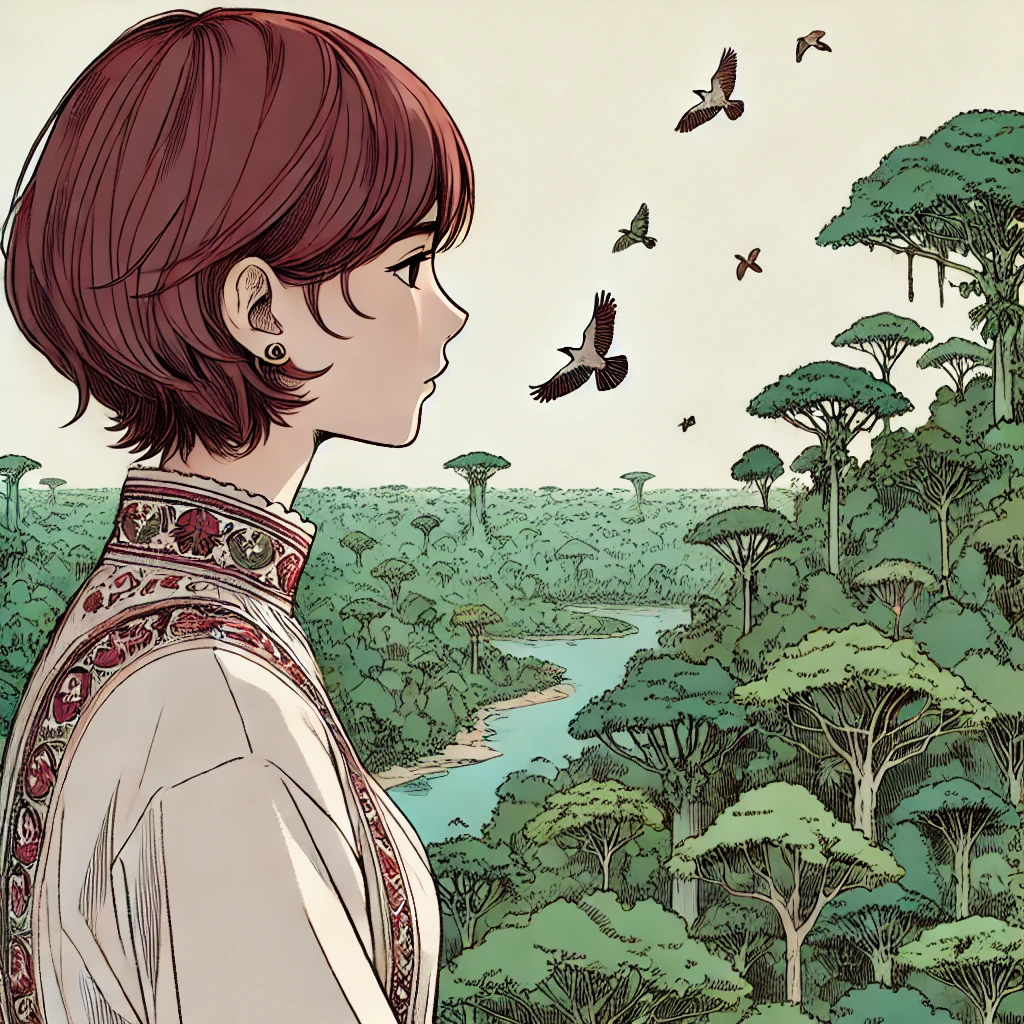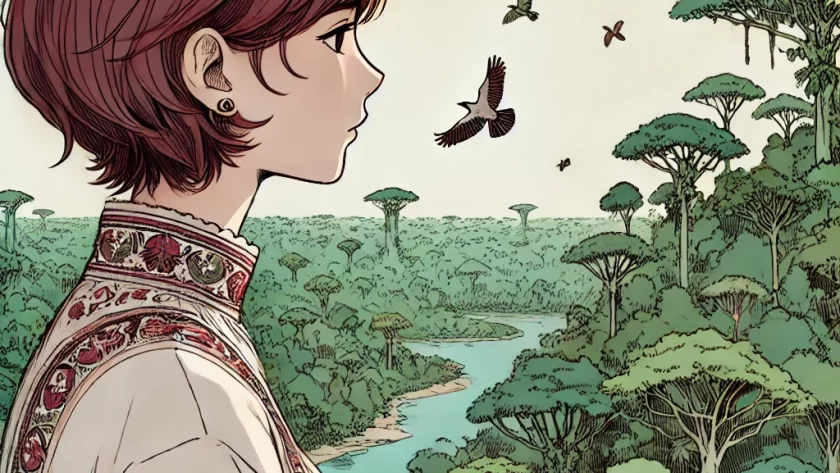風の谷のナウシカ [Kaze no Tani no Naushika]
安田成美 [YASUDA Narumi]
Words : 松本隆 [MATSUMOTO Takashi]
Music : 細野晴臣 [HOSONO Haruomi]
“Nausicaä of the Valley of the Wind = 風の谷のナウシカ / Kaze no Tani no Naushika” is an anime film adapted from a manga series written by Hayao Miyazaki and directed by Miyazaki himself. Although it was made before the establishment of Studio Ghibli, it is often considered a Ghibli work since the later Ghibli production staff were involved.
The song covered in this article, “Kaze no Tani no Naushika,” was composed by Haruomi Hosono as the theme song for the film Nausicaä of the Valley of the Wind. In Japanese, the movie title and the song title are the same, and “Nausicaä of the Valley of the Wind” is just a direct translation of “風の谷のナウシカ / Kaze no Tani no Naushika.”
- 風(かぜ) [kaze] : wind
- 谷(たに) [tani] : valley
Here, let’s explain the particle “の / no.” It corresponds to the English word “of.” Many titles of works by Hayao Miyazaki use “の / no,” and there is a superstition that if this particle is included, the work will be a big hit. Examples include “風の谷のナウシカ / Kaze no Tani no Naushika” (=Nausicaä of the Valley of the Wind), “魔女の宅急便 / Majo no Takkyūbin” (=Kiki’s Delivery Service), “となりのトトロ / Tonari no Totoro” (=My Neighbor Totoro), and “千と千尋の神隠し / Sen to Chihiro no Kamikakushi” (=Spirited Away).
For the past four days, I’ve been introducing music involving Haruomi Hosono. It’s purely coincidental, but I was surprised to find that all of them have something to do with “風 / kaze” (=wind).
The lyrics were written by Takashi Matsumoto, who has frequently collaborated with Hosono since the days of Happy End.
金色の花びら散らして
kin iro no hanabira chirashite
振り向けば まばゆい草原
furimukeba mabayui sōgen
- 金色(きんいろ) [kin iro] : golden
- 花びら(はなびら) [hanabira] : petal
- 散る(ちる) [chiru] : scatter
- 振り向く(ふりむく) [furimuku] : turn around
- まばゆい(まばゆい) [mabayui] : dazzling
- 草原(そうげん) [sōgen] : grassland
(translation) “Scattering golden petals,
When I turn around, there’s a dazzling grassland.”
To delve into the subject of music, however, the song starts in the key of D minor from the intro to the first chord, but then modulates to D major. This is incredible. It’s really cool. It reminds me of the Beatles’ “Michelle,” which uses the reverse logic. I can’t help but think that Haruomi Hosono is like Japan’s Paul McCartney.
雲間から光が射せば
kumoma kara hikari ga saseba
身体ごと宙に浮かぶの
karada goto chū ni ukabuno
- 雲間(くもま) [kumoma] : between clouds
- 光(ひかり) [hikari] : light
- 体(からだ) [karada] : body
- 宙(ちゅう) [chū] : sky
- 浮かぶ(うかぶ) [ukabu] : float
(translation) “If light shines through the clouds,
My whole body floats in the sky.”
The part “浮かぶの / ukabu no” features the particle “の / no,” which adds a feminine touch to the speech. This feminine style of speech is found throughout the lyrics, reflecting the character of the young protagonist, Nausicaä.
やさしさは見えない翼ね
yasashisa wa mienai tsubasa ne
遠くからあなたが呼んでる
tōku kara anata ga yonderu
- やさしさ(やさしさ) [yasashisa] : kindness
- 見える(みえる) [mieru] : visible
- 翼(つばさ) [tsubasa] : wings
- 遠く(とおく) [tōku] : far away
- あなた(あなた) [anata] : you
- 呼ぶ(よぶ) [yobu] : call
(translation) “Kindness is an invisible wing,
You’re calling from far away.”

愛しあう人は誰でも
aishiau hito wa daredemo
飛び方を知ってるものよ
tobikata o shitteru mono yo
- 愛する(あいする) [aisuru] : love
- 愛し合う(あいしあう) [aishiau] : love each other
- 人(ひと) [hito] : person
- 誰でも(だれでも) [daredemo] : anyone
- 飛ぶ(とぶ) [tobu] : fly
- 飛び方(とびかた) [tobikata] : way of flying
- 知る(しる) [shiru] : know
(translation) “Anyone who loves knows how to fly.”
風の谷のナウシカ 髪を軽くなびかせ
kaze no tani no naushika kami o karuku nabikase
風の谷のナウシカ
kaze no tani no naushika
眠る樹海(もり)を飛び超え
nemuru mori o tobikoe
- 髪(かみ) [kami] : hair
- 軽く(かるく) [karuku] : lightly
- なびく(なびく) [nabiku] : flutter
- 眠る(ねむる) [nemuru] : sleep
- 森(もり) [mori] : forest
- 飛び越える(とびこえる) [tobikoeru] : leap over
(translation) “Nausicaä of the Valley of the Wind, hair fluttering lightly,
Nausicaä of the Valley of the Wind,
Leaping over the sleeping forest.”
In this line, “樹海 / jukai” (a sea of trees) is read as “mori” (forest). Using a different word with a similar meaning for the reading is common in lyrics. In this case, “mori” sounds better. See also “Sweet Fake Reading.”
A famous “jukai” in Japan is Aokigahara Forest wiki, located at the foot of Mount Fuji.

青空から舞い降りたら
aozora kara maioritara
やさしくつかまえて
yasashiku tsukamaete
- 青空(あおぞら) [aozora] : blue sky
- 舞い降りる(まいおりる) [maioriru] : descend
- やさしく(やさしく) [yasashiku] : gently
- 捕まえる(つかまえる) [tsukamaeru] : catch
(translation) “When it descend from the blue sky,
Catch it gently.”
花や木や小鳥の言葉を
hana ya ki ya kotori no kotoba o
あなたにも教えてあげたい
anata ni mo oshiete agetai
- 花(はな) [hana] : flower
- 木(き) [ki] : tree
- 小鳥(ことり) [kotori] : little bird
- 言葉(ことば) [kotoba] : words
- 教える(おしえる) [oshieru] : teach
(translation) “I want to teach you
The words of flowers, trees, and little birds.”
何故人は傷つけあうの
naze hito wa kizutsukeau no
しあわせに小石を投げて
shiawase ni koishi o nagete
- なぜ(なぜ) [naze] : why
- 人(ひと) [hito] : person
- 傷つける(きずつける) [kizutsukeru] : hurt
- 傷つけ合う(きずつけあう) [kizutsukeau] : hurt each other
- しあわせ(しあわせ) [shiawase] : happiness
- 小石(こいし) [koishi] : small stone
- 投げる(なげる) [nageru] : throw
(translation) “Why do people hurt each other,
Throwing small stones at happiness?”
Earlier, I mentioned “愛する / aisuru” and “傷つける / kizutsukeru” as basic words. If you have time, it’s also good to learn “愛し合う / aishiau” and “傷つけ合う / kizutsukeau,” as these phrases are commonly used .
風の谷のナウシカ 白い霧が晴れたら
kaze no tani no naushika shiroi kiri ga haretara
風の谷のナウシカ 手と手固く握って
kaze no tani no naushika te to te kataku nigitte
- 白い(しろい) [shiroi] : white
- 霧(きり) [kiri] : fog
- 晴れる(はれる) [hareru] : clear
- 手(て) [te] : hand
- かたい(かたい) [katai] : firm
- 握る(にぎる) [nigiru] : grip
(translation) “Nausicaä of the Valley of the Wind, when the white fog clears,
Nausicaä of the Valley of the Wind, holding hands firmly.”
大地けって翔び立つのよ
daichi kette tobitatsu no yo
はるかな地平線
harukana chiheisen
- 大地(だいち) [daichi] : earth
- 蹴る(ける) [keru] : kick
- 飛び立つ(とびたつ) [tobitatsu] : take off
- はるかな(はるかな) [harukana] : distant
- 地平線(ちへいせん) [chiheisen] : horizon
(translation) “Kick off the earth and take off
Toward the distant horizon.”
Regarding “飛び立つのよ / tobitatsu no yo,” the particle “のよ / no yo” here adds an imperative tone, making it sound like an encouragement to fly rather than the speaker flying themselves. It’s a gentle command, possibly directed at a small animal loved by Nausicaä in the story.
風の谷のナウシカ
kaze no tani no naushika
眠る樹海(もり)を飛び超え
nemuru mori o tobikoe
青空から舞い降りたら
aozora kara maioritara
やさしく抱きしめて
yasashiku dakishimete
Although this song is credited in the title back of the movie, it was not used in the film itself due to a mismatch with the content of the movie. After Hayao Miyazaki discovered Joe Hisaishi, a composer whose music perfectly fits his films, Haruomi Hosono did not compose the BGM for Nausicaä of the Valley of the Wind or any subsequent Ghibli works. This song remains a hidden gem in Hosono’s repertoire.
Narumi Yasuda, who was a 17-year-old newcomer actress at the time, honestly wasn’t a great singer, but her simplicity has a certain charm that I like. It’s perhaps similar to how Miyazaki cast the copywriter Shigesato Itoi as a voice actor (in My Neighbor Totoro).
In 2024, this song was remade under the production of Haruomi Hosono, 40 years later. I highly recommend listening to it, as her voice now carries both maternal and girlish qualities.
YouTube Search ” Kaze no Tani no Naushika – Narumi Yasuda “
Thanks for reading! Feel free to comment if you have any feedback or questions.
Follow me on X.



